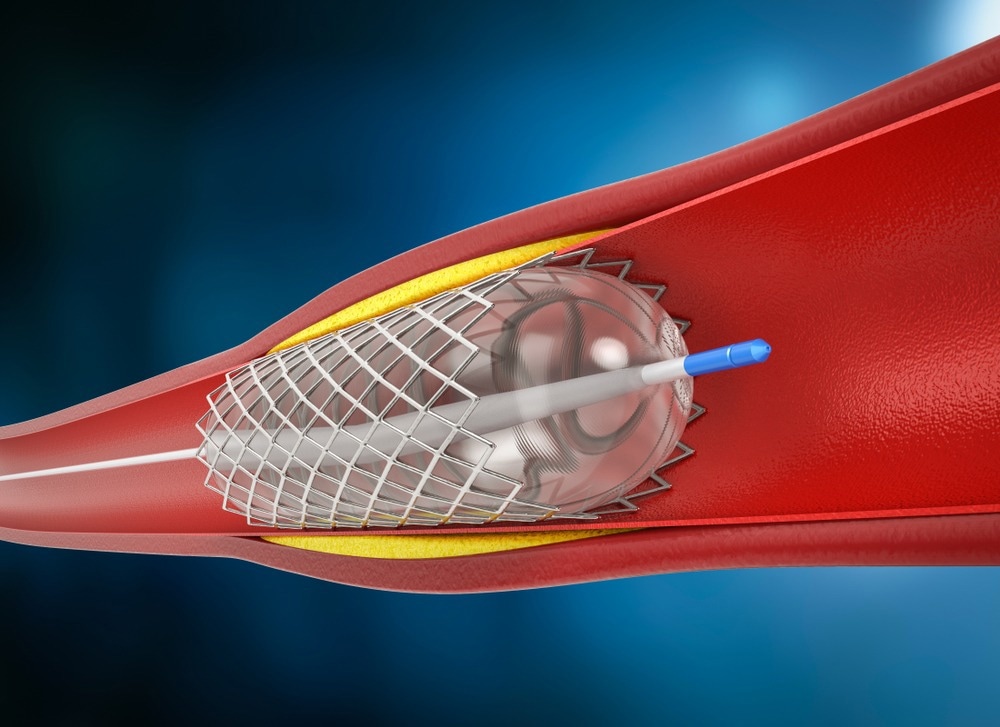Since the first application of stents for the treatment of blocked coronary arteries, many technological advancements have occurred, such as the introduction of bioabsorbable magnesium alloys, to improve clinical outcomes. Cardiovascular stent technology, related to the design, materials, coating, and many other relevant features, is evolving continuously.

Study: Functionalized Fluorescent Nanodiamonds for Simultaneous Drug Delivery and Quantum Sensing in HeLa Cells. Image Credit: Phonlamai Photo/Shutterstock.com
Scientists have recently tested the magnesium (Mg)-based alloy (WE43) with dexamethasone, packed with polymeric nanoparticles, as a stent material. The findings of this study are available as pre-proof in Medical Engineering and Physics journal.
Evolution of Stent Technology
The development of drug-eluting stents (DES) is considered a key achievement in stent technology, as it has significantly decreased restenosis from 20-30% (bare metallic stent) to 3-20% (drug-eluting stent). DES technology involves coating the stent scaffolds with a drug containing permanent polymers. Since its first discovery, DES underwent several modifications, including applying bio-drugs instead of synthetic compounds, different stent designs, various polymeric coating, and differential drug entrapment strategies. Nevertheless, risks of stent thrombosis and restenosis are still associated with DES application.
To reduce the side effects post stent application, permanent materials of stent scaffold were replaced with bioabsorbable materials. As these materials have successfully eliminated the risk of thrombosis, there is no need for prolonged antiplatelet therapy. Compared to bioabsorbable polymeric materials, applying metals and metallic alloys for the development of stent scaffold exhibits extraordinary mechanical properties and optical opacity required for X-rays.
Magnesium and its alloys have been proposed as promising materials for metallic stent scaffolds because of their significant biocompatibility and mechanical properties. Nevertheless, due to high electrochemical activity, Mg and Mg-based alloys are prone to rapid corrosion. This drawback limits the production of Mg-based drug-eluting stents. Interestingly, implementing different coatings based on graphene oxide or micro/nanaoparticle has improved the performance of Mg-based stents.
Dexamethasone (Dexa) is a therapeutic agent that possesses anti-inflammatory properties and inhibits smooth muscle cell (SMCs) proliferation. Application of Dexa in DES technology exhibited satisfactory clinical outcomes.
Evaluation of Mg Alloy WE43 Coated with Dexa Loaded Nanoparticles as a Stent Material
Recently, scientists evaluated WE43 (coated with Dexa-loaded nanoparticles) as a new stent material using the electrospraying method. The nanoparticle-coated surface was analyzed using scanning electron microscopy (SEM), which revealed that the nanoparticles were round in shape and the size of most of the nanoparticles was below 200 nm. SEM analysis also exhibited the homogenous nature and distribution of nanoparticles. Size, morphology, and dispersion of nanoparticles play an important role in drug release profile and cellular uptake.
Several studies have indicated that nanoparticles of size between 100 and 200 nm can penetrate the inner layer of vessel walls and deliver therapeutic agents. Therefore, given the size of the newly developed Dexa-loaded nanoparticles coated on the WE43 stent, it is expected that they will reach the target site by penetrating the inner vessels of the coronary arteries and enable effective drug delivery.
The evaluation of the material's surface characteristics revealed that the surface roughness of the coating of the nanoparticles was around 700 nm, which contributed to its enhanced surface hydrophobicity. To analyze the drug release property, researchers compared the releasing property of two groups of samples, i.e., WE43 and stainless steel. Releasing profile exhibited that 25% of Dexa was released within the first five hours. Interestingly, scientists observed a similar drug release pattern, in both groups, for 120 hours, and around 60% of Dexa was eluted.
A sudden escalation of drug release was observed in WE43, compared to stainless steel, because of the initiation of the degradation process. Degradation enhanced nanoparticle detachment from the surface resulting in more elution of Dexa. Typically, to prevent restenosis, sustained drug release for three weeks is required to inhibit SMCs proliferation and migration.
An MTT assay was performed to analyze the inhibitory effect of three groups, i.e., surface coated with nanoparticles (SNP), surface coated with drug-loaded nanoparticles (SDLN), and Dexa solution on the cell proliferation of SMCs. After 24 hours, cell viability decreased significantly in all the groups, i.e. SLDN (60.7%), SNP (91.8%), and Dexa solution (93.3%). Nevertheless, after 72 hours, the inhibitory effect of SLDN and SNP increased significantly and the Dexa solution remained constant. One of the key reasons for decreased cell viability was increased Mg ion concentration. Mg ion concentration might have also contributed to the absence of Human Umbilical Vascular Endothelial (HUVEC) on the bare metal surface, which was evaluated via SEM analysis.
Future Outlook
Taken together, Dexa-loaded nanoparticles coated on the WE43 plate could be applied as bioabsorbable drug-eluting stents due to their sustained drug releasing capacity. Additionally, inhibition of SMC proliferation without affecting endothelial cell proliferation was observed through in vitro culture experiments. This finding supports the increase in its applicability as an improved stent material.
Reference
Lakalayeh, A.G. et al. (2022) Evaluation of drug-eluting nanoparticle coating on magnesium alloy for development of next generation bioabsorbable cardiovascular stents. Medical Engineering and Physics. https://www.sciencedirect.com/science/article/pii/S1350453322001266
Disclaimer: The views expressed here are those of the author expressed in their private capacity and do not necessarily represent the views of AZoM.com Limited T/A AZoNetwork the owner and operator of this website. This disclaimer forms part of the Terms and conditions of use of this website.